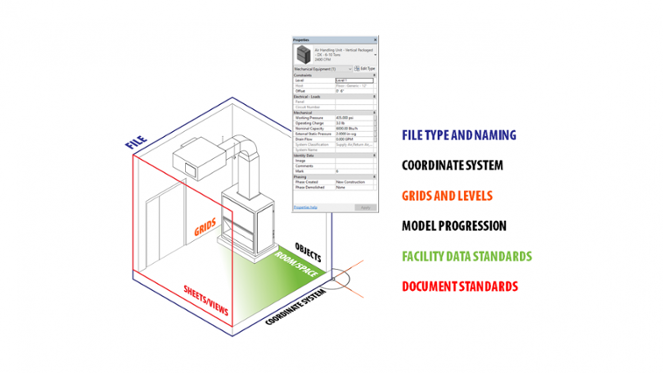BIM Guides and Execution Plans Improve Data Quality

Designing, constructing and maintaining a facility is challenging. These challenges are influenced by the size and complexity of the project and the experience and capability of the project team. There is a constantly expanding plethora of new software solutions that are built to solve the many pain points in the building lifecycle. As organizations adopt and implement BIM workflows supported by new software into their standard processes and delivery, special care is required to ensure that each of these BIM workflows work together seamlessly to support the organization’s goals and mission.
Our industry is unique as each project executed brings a new combination of organizations and individuals, who must work together cohesively to achieve a common goal. The implementation and execution of BIM, therefore, is a similarly collaborative effort, which combines the individual workflows of each organization into a master project workflow. This reality is well appreciated by anyone who has been part of a project team, and this challenge presents itself in all components of a project delivery, not just BIM. Additionally, if that was not already difficult enough to accomplish, each project delivery workflow fits within a larger client’s program workflow, which seeks to achieve consistently successful outcomes from a multitude of varied project delivery strategies, organizations, and individuals.
Fortunately, VueOps has a wealth of experience helping our clients overcome these multi-faceted challenges by establishing effective BIM Guides and BIM Execution Plans.
The Solution
What are they, and how are they different?
BIM Guides (aka BIM Implementation Plans) are documents that describe a given organization’s BIM goals, identify the BIM uses adopted by that organization, and sketch out (sometimes in step-by-step or click-by-click detail) the standard processes that have been implemented to support the identified BIM uses (and by conjunction, the organization’s BIM goals). These standard processes consist of both the primary processes that result in specific BIM use outcomes, and the secondary, sometimes manual, processes required to bring all those processes into a cohesive workflow. The creation of this information repository, and its refinement into a carefully constructed tool for communication, is key for successful intra-organization alignment and inter-organization collaboration.
While a well-constructed BIM Guide will help ensure internal alignment and help communicate with external parties, the project environment requires a different sort of tool, the BIM Execution Plan. In a collaborative cross-disciplinary environment, it is important to ensure that the various processes required for each organization’s workflows work in concert with every other organization’s workflows.
A comprehensive BIM Execution Plan for a project pulls in the relevant processes from each organization’s BIM Guide along with any project-specific workflows developed to integrate, combine, and augment each discipline’s processes. BIM Execution Plans are also built to serve the needs of specific individuals on a given project, as many workflows can be accomplished using a variety of software tools, the selection of which will be determined by the individual responsible for the work. These documents should be developed collaboratively by the entire project team but should also always consider how the client intends to use the models and data post-construction.

BIM Guides and Execution Plans Create Quality Data
While BIM Guides and Execution Plans are most successful when all parties have considered their needs, we have seen successes at every phase of a facility’s lifecycle when even partial plans are in place.
Designers have seen the advantages of quality data for years. Just by using dynamic schedules, they can create a live connection between equipment schedule information and the annotations on drawings. This reduces room for errors and ensures alignment of information conveyed to users downstream.
Having a plan can drastically improve the quality of data organization during and after a project which promotes better alignment with other project documentation used to communicate between all project stakeholders.
Clients with clearly defined goals are more likely to receive quality products at the end of a project. Additionally, the product received is consistent from project to project regardless of the size or method of delivery. This quality data reduces facility engineer’s uptime for assessing problems, finding vital information, and fixing or maintaining assets.
Just with basic data standards and checks our clients and project teams have been able to catch deviations from the plan in the beginning phases of a project, enabling them to promote proper data practices and correct their course of action for the next phase.
How can VueOps help?
VueOps provides expertise in Building Information Modeling and Facilities Management (BIM-FM) through a software as a service (SaaS) to help teams extract valuable facilities management data from design and construction and turn it into building intelligence. We help you plan and execute strategies to keep your building’s dataset accurate allowing you to streamline facility management (FM) processes, improve operational workflows, increase efficiency, and prevent downtime.
As part of our service offerings, VueOps works with many types of AECOO organizations to better understand their internal requirements to write BIM Guides and Standards and template BIMx Plans.


